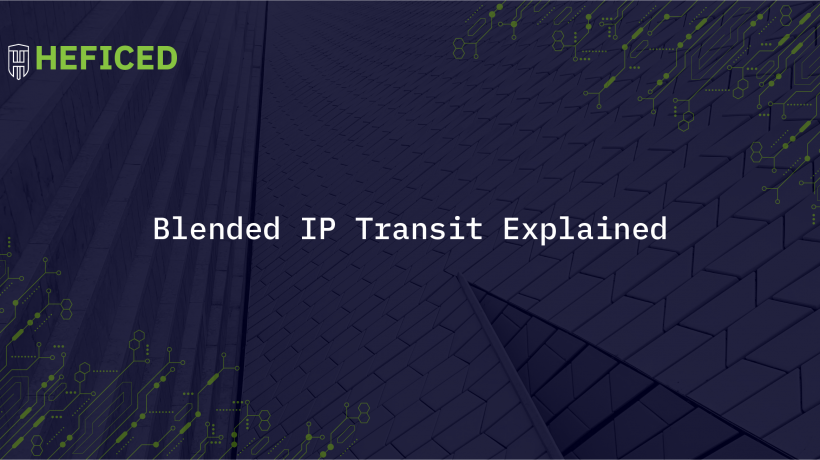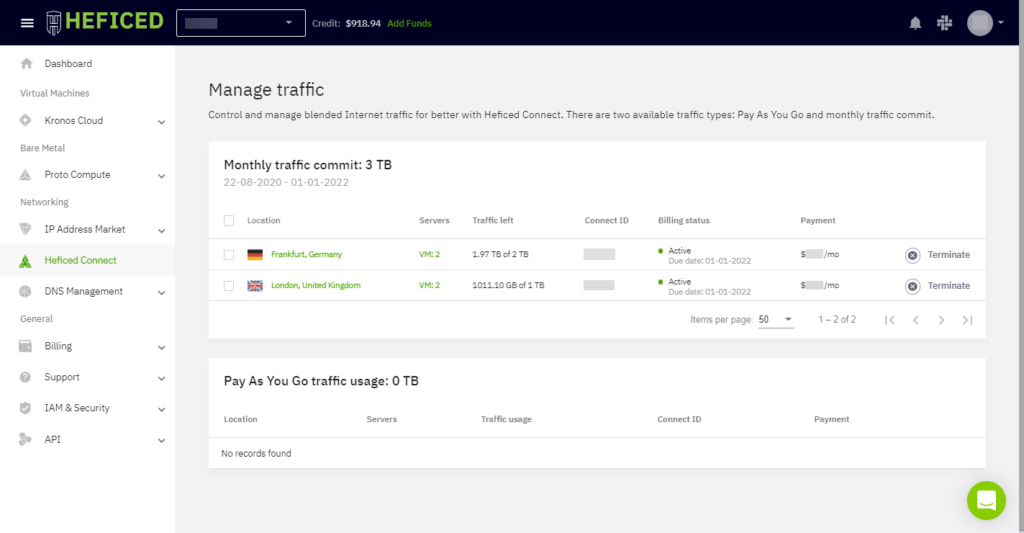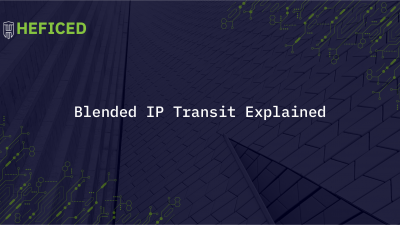Heficed Blended IP Transit Explained

Internet transit is the service where a network operator allows smaller Internet Service Providers (ISPs) to pass through their network to connect to the rest of the Internet.
If your company utilizes the Internet in any capacity, then you should be familiar with IP transit. However, having a better understanding of IP transit will allow you to make better decisions about how your business accesses the Internet and how your customers reach your applications and services.
What is Blended IP Transit?
Sending and receiving information across the Internet requires you to transit one or more third-party networks to reach your destination. According to Heficed’s Network Team Lead, Andrius Madeliauskas, “IP transit is a type of Internet connection that is used to announce a smaller company network IPs to the large Tier 1 providers.”
Here, “Transit” means that client company IPs pass via the IP Transit provider to the whole Internet. Blended IP transit providers are connected to multiple large Internet ISPs or Tier 1 providers.
Tier 1 IP Transit providers have a global reach. They are connected with each other and act as conduits to connect the globe. In short, they are the backbone of the Internet. Tier 1 networks are interconnected by design and are subsequently connected to the lower Tier 2 and Tier 3 networks. Tier 1 providers connect to each other free of charge but charge lower-tier networks to access their network.
Tier 2 providers have many physical locations and data centers. They typically peer with each other free of charge to expand their delivery capability and avoid using Tier 1 networks.
Tier 3 providers are mostly local ISPs. These providers typically purchase smaller portions of IP transit through a Tier 2 provider to avoid the higher costs of going directly to a Tier 1 provider.
However, depending on how well an ISP is connected, each tear of IP transit can have varying quality levels. So your IP transit provider must have robust Internet connectivity for you to scale your company’s growth.
Datacenter Internet can be much more sophisticated. According to Heficed’s Network Team Lead, Andrius Madeliauskas, “with the help of dynamic routing, data center connections can be redundant with multiple Internet providers.” This redundancy can be achieved with automatic traffic balancing instead of the “main/backup” type of redundancy. Such traffic balancing can be done with the use of blended traffic.
Hence, blended IP transit enables the network administrator to set policies for intelligent routing decisions. Blended IP transit gives routers the ability to find alternative connections if the default path is unavailable, thus, improving connection speeds and reducing downtime.
What are the Benefits of Blended IP Transit?
Blended IP transit provides robust and consistent internet connectivity. It offers a blended bandwidth solution, taking advantage of the combined upstream connectivity of multiple ISPs across a fully managed BGP routing platform.
High demands on cross-network traffic coupled with limited bandwidth cause cross-network traffic to become congested, and as a consequence, users may experience substantial delays and packet losses. Blended IP transit provides a solution to this problem by directly peering to Tier 1 ISPs
Blended IP transit service providers work with select networks of Tier 1 ISPs to achieve stable connectivity with the help of BGP. The route through the best possible networks, reducing latency and providing the most substantial available bandwidth, ensuring minimal packet loss. As a result, it removes all access interruptions and eliminates the chance of revenue disruption for companies.
A Blended IP Transit service with extensive peering arrangements with large content networks allows the provider to achieve reliable connections throughout all the Internet Exchange Access points with which they participate.
Furthermore, having blended IP transit instead of default IP transit provides better visibility on the Internet. With more Internet providers and dynamic routing, various Internet destinations can be reached via a shorter path.
Generally, the more ISPs in the IP transit blend, the shorter the average network path is to the desired destination. A shorter network path provides lower latency to the destination. Low latency is vital to many Internet services, including but not limited to CDNs, game servers, proxy services, and VPNs.
While regular home user Internet connections typically have one ISP, businesses, on the other hand, often need redundant ISPs for mitigating situations when the main provider encounters issues.
Using blended IP traffic solutions provide companies with the ability to use multiple ISPs. If one ISP goes down, the BGP will reroute traffic using another ISP. Several ISPs allow a company to continue working via their redundant ISP. Blended transit provides a reliable Internet connection, eliminating potential access interruptions that may hamper business operations.
Heficed network is configured to pass through BGP communities and AS61317 provides BGP Communities to help control the scope and route preference of traffic. To read more about the way BGP Communities work or use the feature, read our blog post.
What are the differences between Domestic, Blended, and International IP transit?
Not all ISPs are equal as some are more regional, while others are more international. These differences can significantly affect the quality of blended traffic.
If IP Transit has multiple local ISPs or Internet Exchanges (IXs), such a blend will be oriented toward Domestic traffic. This doesn’t necessarily mean a bad thing, as this type of blend is ideal for game servers and CDNs (Content Delivery Networks).
If IP Transit has more global, Tier 1 ISPs, such a blend will be oriented toward international traffic and will theoretically provide lower international traffic latency, which is more convenient for VPNs or proxies.
Generally speaking, the more connections between networks a request needs to make traveling from client to server, the more latency and throttling will be. A hop to another server requires time to get the desired routing. In most cases, larger networks will provide fewer hops to fulfill the same request.
In closing, blended IP transit is the answer for companies looking for the highest availability and performance for their hosted services. Blended IP transit is performance-optimized as its providers are connected to multiple Tier 1 networks and public peering exchanges, ensuring fast, low latency connections.
Blended IP transit provides a reliable internet connection, preventing potential access interruptions that could obstruct business operations. This resilient connectivity reduces possible access interruptions and consequential disruption of revenue streams to zero.
More importantly, using multiple ISPs at the same time isolates companies from issues within ISP networks. When using multiple ISPs, the BGP will automatically reroute traffic over another ISP if one goes down.
How Does IP Transit Work?
You can control and manage blended Internet traffic with IP Transit. It bridges your network with the rest of the world, powering your enterprise and enabling mission-critical operations.
Our solutions enable data to be sent and received faster than most IP transit providers. With several PoPs in critical locations, IP Transit grants your business a global reach, 24/7/365. Your enterprise will enjoy more extensive protection from problems related to power outages and latency, allowing all manner of transactions — email, purchases, or inquiries — to continue without hiccups.
There are two available traffic types: pay as you go (Cloud Servers only) and monthly traffic commit. IP Transit calculates each byte of outgoing data from all your servers in the same location connected to the IP Transit service. Choosing the pay as you go option allows you to pay only for the traffic you use, while a monthly commit is a fixed payment for the allocated bandwidth.
If you’re interested to learn more about blended IP transit connectivity, visit our website


